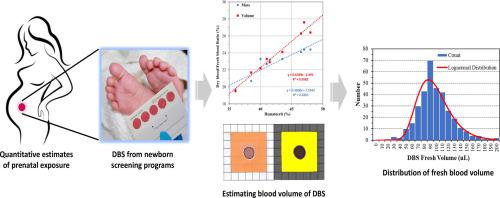Forensic Chemistry ( IF 2.7 ) Pub Date : 2024-01-26 , DOI: 10.1016/j.forc.2024.100552 Sung-Hee Seo , Stuart Batterman

|
Archived dried blood spots (DBSs) collected by newborn screening programs represent a potentially valuable resource for assessing chemical exposure of newborns. Moreover, collection, storage and transport of DBSs are easier and cheaper than standard venipuncture protocols. However, quantitative exposure assessment requires knowledge of the blood volume, which can vary considerably on DBSs. We present a method to estimate the volume of fresh blood originally deposited on DBSs, and update the forensic literature regarding the ratio of fresh blood volume to dry blood weight. The weight of the blood residue is determined using the area and areal density of the DBS corrected by an unused section of the same card. Density is determined by cutting out the DBS, scanning and digitizing the image, and applying a mask to improve consistency. Blood volume is calculated as the product of the residue weight and fresh blood volume/dried blood weight ratio for the age-specific hematocrit level. Tests using DBSs prepared with 30 to 100 µL of blood showed excellent agreement. The method was applied to 352 archived neonatal DBSs dating from 2008 through 2023. The estimated fresh blood volume averaged 98 µL, close to the expected value, and followed a lognormal distribution (range: 28 to 199 µL); no differences were found for sex or DBS age. The proposed approach is simple, accurate, and inexpensive, and can facilitate the use of archived DBSs for quantitative and retrospective exposure assessment. Additionally, it is applicable for forensic applications examining bloodstains on cloth, paper, and other materials.
中文翻译:

估计干燥血点上的血量
新生儿筛查项目收集的存档干血斑 (DBS) 是评估新生儿化学暴露的潜在宝贵资源。此外,DBS 的收集、存储和运输比标准静脉穿刺方案更容易、更便宜。然而,定量暴露评估需要了解血容量,而 DBS 上的血容量可能会有很大差异。我们提出了一种估计最初沉积在 DBS 上的新鲜血液体积的方法,并更新了有关新鲜血液体积与干血重量之比的法医学文献。血液残留物的重量是使用 DBS 的面积和面密度来确定的,该面积和面密度由同一张卡的未使用部分校正。密度是通过剪切 DBS、扫描和数字化图像以及应用掩模来提高一致性来确定的。血容量计算为残余重量与年龄特定血细胞比容水平的新鲜血容量/干血重量比的乘积。使用用 30 至 100 µL 血液制备的 DBS 进行的测试显示出极好的一致性。该方法适用于 2008 年至 2023 年 352 例存档的新生儿 DBS。估计的新鲜血量平均为 98 µL,接近预期值,并遵循对数正态分布(范围:28 至 199 µL);性别或 DBS 年龄没有发现差异。所提出的方法简单、准确且廉价,并且可以促进使用存档的 DBS 进行定量和回顾性暴露评估。此外,它还适用于检查布料、纸张和其他材料上的血迹的法医应用。



























 京公网安备 11010802027423号
京公网安备 11010802027423号